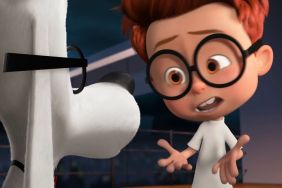
Saving Mr. Banks is a tale of two halves. The first half involves a rather standard setup with more flashbacks than any film need utilize. We’re introduced to the ever lovable and determined Walt Disney (Tom Hanks) and the persnickety P.L. Travers (Emma Thompson), author of “Mary Poppins”, a book Disney had promised his daughters he’d make into a movie and has spent the better part of 20 years trying to convince Travers to sell him the rights.
However, as much as I grew tired of the looks back on the early life of Travers as the story builds, the second half puts all of those flashbacks into perspective, resulting in a wonderful third act where Thompson shines, giving the film an emotional weight that’s as welcomed as much as it is cliched. Hollywood may revel in making movies about making movies, but it’s hard to fault them as working with what you know is often a key to effective storytelling and while Saving Mr. Banks isn’t a film for the ages, it makes for a satisfying way of spending a couple hours.
In terms of performance, Hanks almost fits the role of Disney too well, either that or he is pretty much just playing himself, but it hardly matters as this is the Emma Thompson show. In fact, the film belongs to almost everyone but Hanks, even though Disney and Travers share a wonderful moment towards the film’s end. I don’t think it’s any measure of a spoiler to tell you Mary Poppins eventually gets made, and to watch Thompson react to the finished project is the climactic moment of Mr. Banks, seconded by an unexpected gem of audio during the end credits.
Extending beyond the two obvious leads, Paul Giamatti gives Travers’ personal chauffeur, Ralph, the kind heart Giamatti is prone to giving the characters he embodies and Colin Farrell, playing Travers’ father in flashback sequences of the author’s tough upbringing in Australia, is great, even though his scenes are largely filled with traditional storytelling tropes as he must play the down-on-his-luck, but loving, father who eventually turns to alcohol for companionship. Nevertheless, his relationship with his daughter (played by 11-year-old Annie Rose Buckley) serves the latter half of the film well.
Consistently entertaining are Jason Schwartzman and B.J. Novak as the songwriting brothers, Richard and Robert Sherman respectively, and Bradley Whitford as screenwriter Don DaGradi as the trio eventually find themselves locked away with Travers, bending to her every whim and request as to how the story of Mary Poppins should be told, which is to say, most importantly, “No animation!” To that point, her query over how they are going to get actual penguins to dance is yet another one of the film’s highlights.
I was a little surprised at how uninteresting Thomas Newman‘s score for the film was, but then again, the music here is less about the score and more about the now-iconic songs. The costuming is great and I expect Disney fanatics will love every second as it is awash in Disney lore, this being only the third feature film to ever shoot on the hallowed Disneyland grounds… with permission that is.
The biggest issue the film faces is the opening hour or so. Screenwriters Kelly Marcel and Sue Smith dedicate so much time to flashbacks and set up that it grows incredibly tiresome. I understand it’s all in an effort to establish the characters for the third act climax, but the story gets bogged down in particulars that seem largely routine for most every film of this sort. The saving grace is Thompson’s performance and perhaps in the hands of a lesser performer it wouldn’t have held nearly the same impact.
By the film’s end, Saving Mr. Banks is an accomplished feature with great performances and an enlightening story. The peek behind the Disney curtain is obviously without much controversy and largely a softball lob down the middle, but it’s both pleasing and entertaining once you get to the heart of the story, just that opening hour is a bit of a chore.









